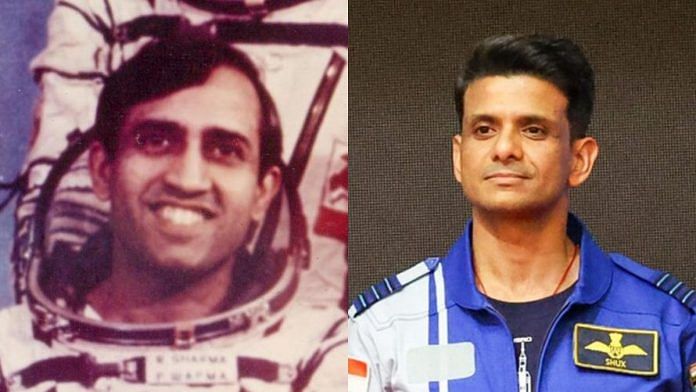New Delhi: It was a 41-year wait for Indians before they could finally witness one of them put on an astronaut suit, strap into a rocket, and launch into space. Rakesh Sharma did it in 1984, and Shubhanshu Shukla in 2025. The time, the place, and the mission were vastly different, but what did not change was the fervour with which their countrymen rooted for their success.
As part of the Axiom-4 mission, a private human spaceflight led by US space company Axiom Space, Group Captain Shukla of the Indian Air Force (IAF) reached the International Space Station (ISS) on Thursday. He became the first Indian to ever set foot in the facility.
After multiple delays, the mission finally took flight from the NASA Kennedy Space Center on Wednesday, onboard SpaceX’s Falcon-9 rocket. First, the weather, and then leaks observed in the rocket and the Russian module of the ISS, delayed the launch for nearly a month.
But when the rocket finally took off, the wait seemed worth it.
Now that Shukla has reached the ISS, his 14-day stay will be spent leading seven experiments developed by top Indian research institutions. He will also participate in over 60 scientific experiments and other activities in microgravity.
With India preparing for its first human spaceflight, Gaganyaan—set to launch by 2027—Shukla’s flight to space comes as an important pre-game experience, and that is why India’s human spaceflight journey from Sharma to Shukla is ThePrint Newsmaker of the Week.
Sharma to Shukla
IAF Wing Commander Rakesh Sharma was 35 when he was chosen to be a part of the Soviet mission, Soyuz T-11, in 1982.
His interaction with then-Prime Minister Indira Gandhi from the Russian space station Salyut 7 is etched in history. When asked how India looks from space, he proudly said, “Saare jahan se accha”.
Sharma‘s selection for the USSR mission was a significant moment in history, not just for India but for the global collaborative space programme.
During the Cold War, between 1947 and 1991, the Soviet Union introduced the Intercosmos initiative to partner with allied and friendly countries. India got a chance to send an astronaut-designate as part of this deal.
Sharma, who was a squadron leader back then, was also a test pilot with the IAF. This automatically qualified him as a possible applicant.
But this was just the first step to a strenuous two-year training.
He underwent several training rounds and beat over 150 candidates before his selection. The training involved facing high G-forces or gravitational force equivalents, sensory deprivation tests, and cardiovascular and vestibular stress simulations.
“But it was all worth it. No matter how hard you train, nothing can completely prepare you for space,” Sharma said in an earlier conversation with ThePrint.
For Shukla, who was born a year after the Soviet mission, Sharma became a hero.
Still unsure of whether he would be able to fly to space like his idol, he followed Sharma’s footsteps to become a test pilot first.
In 2019, his dream came true. The Indian Space Research Organisation (ISRO), which had been working to develop the country’s human spaceflight, called for applications from test pilots from the IAF to be a part of the mission.
Along with Shukla, Group Captain Prasanth B Nair, Group Captain Angad Pratap, and Group Captain Ajit Krishnan were also chosen to be a part of India’s much-awaited Gaganyaan mission.
Thus began nearly four years of training for India’s very own human spaceflight. And it was midway through training for Gaganyaan that the opportunity for Axiom-4 came up. Shukla became the chosen one, with Nair as his backup crew in the mission.
Setting the stage for Gaganyaan
Sharma and Shukla’s missions are starkly different—though equally significant—not only because of the countries leading them, but where they stand in history.
Axiom-4, with Shukla as the mission pilot, comes at a time when the Indian space programme is powering through. It has already reached the Moon and aims to build its very own space station, Bharatiya Antariksh Station, by 2035. In the five years after that, India aims to land a human on the Moon.
ISRO is also designing missions to explore Venus and Mars, and bring back samples from the Moon. With the Indian Space Policy 2023, the government has also opened the sector to private players.
Astrophysicist and Ashoka University vice-chancellor Somak Raychaudhury said that learnings from Axiom-4 will help improve India’s own human spaceflight.
“There would be a lot of tech and logistical learnings from the mission that we will be able to implement in Gaganyaan,” he added.
The mission’s impact will go beyond policy rooms, labs, and launch pads to classrooms, social media, and public discussions.
Axiom-4 marks the beginning of India’s space aspirations for the decades ahead. And Shukla has become the face of it.
Views are personal.
(Edited by Prasanna Bachchhav)






